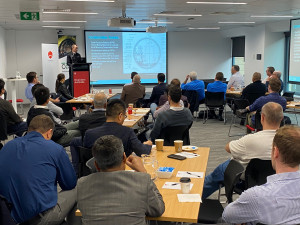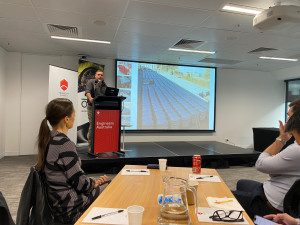The one-day workshop showcasing tunnel projects in Queensland was attended by 52 ATS Members and Delegates at Engineers Australia, 340 Adelaide St, Brisbane on 6th October 2022. The major sponsor was the Aurecon Group. Attendees enjoyed the informative workshop and conveyed their appreciation to the organiser Andrew Ridout, the ATS and Aurecon.

The first speaker was Tai Luong, Project Director (Tunnels, Stations & Development) at Cross River Rail Delivery Authority. Tai gave an update on the project, which includes 10.2 kilometres of new rail line, rail station rebuilds from Fairfield to Salisbury as well as Exhibition and Dutton Park; the new station developments at Roma Street, Albert St, Woolloongabba and Boggo Road; as well as the Tunnel Boring Machine (TBM), roadheader tunnelling and conventional mining excavation works.
The 5.9 kilometres of twin tunnels under the Brisbane River and CBD are now complete and station developments are underway. Albert St Station is Brisbane’s deepest hole with excavation to 50m. Most of the tunnel spoil has gone to the Brisbane Airport. The Cross River Rail Project will provide 7,700 jobs with 1,700 contractors and suppliers and will provide future passenger rail access across the Brisbane River.
The second presentation on Pre-cast Concrete was by Colin Ginger, General Manager of the Pre-Cast Concrete Group, specialists in segment pre-cast concrete for smaller tunnel projects and architectural facades using glass fibre reinforced concrete (GRC) lightweight concrete. Colin described the process of mould preparation, concrete pouring and materials handling of the 21,000 pre-cast segments for the Gold Coast De-Salination Plant. The process to obtain high early strengths by pre-heating moulds and heating during the early curing process gave a concrete strength of 12 MPa at mould stripping after eight hours.
The presentation by Patrick Kidd, Principal Engineering Manager for the Inland Rail Project, covered the proposed national 1,700km rail infrastructure project for the Australian Rail Track Corporation (ARTC) on behalf of the Australian Government. This will deliver critical enhanced freight rail capacity between Melbourne and Brisbane and enable the faster and safer transportation of goods.
In south-east Queensland there are a number of tunnel projects including the Toowoomba Range Tunnel (6.4km), the Little Liverpool Tunnel (911m) and the Woolaman Tunnel (985m). The rail system will be capable of transporting double stacked containers and will include 11 viaducts and 21 level crossings and will provide 21,500 jobs at the peak of construction. Patrick outlined the liaison required between Federal and State Governments and the importance of the inland Rail to Regional communities. The Inland Rail will be commissioned from south to north with completion expected in 2028.
National Chairman of ATS, Dr Harry Asche, who is the Design Director – Tunnels at the Aurecon Group, gave an interesting description of three major tunnelling projects completed in Brisbane in the 1990’s and 2000’s, all of which Harry had a major engineering involvement when employed by Connell Wagner. These projects were the Brisbane Rail Tunnels from 1991 to 1995 which included the duplication from Roma Street to Central Station and the Central to Fortitude Valley Rail tunnel, the South-East Transit Project (Busway) in 1997 and the S1 Sewer from Taringa to Luggage Point from 2002-2005. Harry outlined the challenges of each project as well as the early use of Mitsui S200 roadheaders by Concrete Construction on the rail tunnels, and the use of an earth pressure balanced (EPB) TBM in the colluvium under Brisbane Airport.
Ulrike Pelz, Senior Technical Director – Tunnels and Major Projects – GHD Pty Ltd gave an interesting presentation on Cross River Rail Reflections on TBM tunnelling and other adventures. Ulrike explained how the two Cross River Rail TBMs Else and Merl got their names from early women pioneers in engineering and women’s rights, Else Shepherd and Merle Thornton. The TBMs, which came out of the Sydney Metro and weighed in at 1350t each and 165m long, each advanced approximately 4km of tunnel and produced a total of 290.0000 cum of spoil. In addition, Ulrike provided detail on the geological and geotechnical aspects of the Albert St Cavern in hard rock and the development of the shafts and infrastructure for TBM operations, as well as addressing issues such as settlement and soft ground conditions.
Roger Ness Wilson, Operations Manager of Kings Engineering at Rutherford, Newcastle, gave a presentation on the engineering advances made in Mitsui 300 Roadheader rebuilds at Kings over the past three years. Kings are part of the Bloomfield Coal Group and up until 2019 were mainly responsible for in-house rebuilds of all types of machinery, including Vermeer surface miners. Since then there have been ongoing Mitsui rebuilds with fantastic liaison with Mitsui and the tunnelling contractor clients. Use of “reverse engineering” concepts by Kings have resulted in an improved product with wear in major components of the rebuilt machines reduced when returned to operation.
The final presentation was a group presentation on the Breakfast Creek Trunk Sewer Augmentation Project by Urban Utilities, Fulton Hogan and Rob Carr Drilling. Presenters included Steven Harding of Urban Utilities, Felipe Villafrade of Fulton Hogan and Thierry Candito and Andrew Scarr of Rob Carr Drilling. The project was initiated to overcome a blockage due to sagging in the existing pipeline and the solution was a new underground bypass line located in a microtunnel to be bored by a Herrenknecht machine which will be lowered by Rob Carr Drilling into a launch shaft 15m deep x 9m diameter.
To build the new trunk sewer main, Perry Park has become a construction area and site compound for the 18 months to two-year project. Urban Utilities and their delivery partner, Fulton Hogan Utilities have started site establishment in Perry Park, Bowen Hills with delivery of site fencing, office structures, equipment and material, and segmental sunk caisson shaft is underway. The large fig tree adjacent to Edmondstone Road will be protected. As part of the works, the existing Perry Park playground and facilities will be temporarily relocated to a suitable green space nearby for community use during the life of the project until late 2024. The new pipeline will provide additional system storage capacity.








